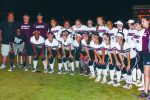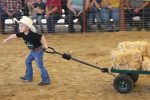Spike Strawn: World War II American hero
By Todd Blomerth
Special to the LPR
Editor’s note: this is part three in a three-part series by Todd Blomerth
Okinawa was soon split in two. The Sixth Marine Division swung north. Resistance grew worse as the division advanced. Soon, the remaining Japanese were isolated and destroyed. As noted in Spike’s notes the northern portion of the island was secured by April 22.
The Sixth Marine Division was ordered south. There, over 100,000 Japanese soldiers, marines, naval personnel, along with conscripted Okinawan labor units had turned the island’s southern mountains into an almost impenetrable fortress. The Americans’ naval and air superiority seemed to have little effect against an enemy using an enormous array of tunnels, caves and ingenious defenses commanded by the brilliant General Mitsuru Ushijima. Spike’s notebook entries rarely contain personal reflections. However, the futility of the battle becomes vivid in entry after entry of tanks destroyed, men killed, horrible weather, and combat exhaustion.
One can’t read these shorthand versions of hell, without being moved. Spike speaks of fifty days of rain, of mosquitoes, of casualty figures that beggar the imagination.
Shuri Castle, the Gorge, Tombstone Ridge, Dead Horse Gulch, Naha, Kakazu Ridge, the Pinnacle, Wana Draw. These became names synonymous with misery and death. Rains began, and the front lines began to appear like something out of World War I trench warfare.
The enemy was often unseen, hidden in caves and spider holes. High points were taken and lost. Tanks were destroyed by artillery or mines. The killing seemed to go on forever. The horrific battle in Okinawa’s “Death Valley,” resulted in death to hundreds, perhaps thousands of Japanese. “There were 500 to 700 bodies, all over the place,” Spike remembered.
Finally, the weight of American force pushed the remaining Japanese into a smaller and smaller area. By the end of May 1945, over 50,000 Japanese had been killed – yet the battle was far from over. The 6th Marine Division were loaded on ships and made another amphibious landing, helping seal the doom of the remaining defenders
Suddenly, it was over. The cost was dear. Over 12,000 soldiers, sailors and marines died in the fighting and defending against kamikaze air attacks. It is estimated that over 110,000 Japanese died, either in the fighting or by suicide. Sadly, Okinawan civilian losses were huge – well over 100,000. Adding to that, the islanders had been told repeatedly that Americans would rape the women and kill the men. Those Okinawans not used as slave labor and killed during the fighting, had to be convinced that what had been told them was a lie. “The civilians just knew we were going to kill or rape them, because that is what they’d been told.” Instead, Americans went out of their way to assure them of the opposite. GIs and marines handed out water, food, and medical supplies to everyone in need.
Like thousands of other fighting men, Spike was diagnosed with “combat fatigue.” He shipped home to USNH San Leandro, dealing with what we now call PTSD. Finally, in December 1945, Sergeant Spike Strawn was honorably discharged from the United States Marines. He’d lost over thirty pounds while in combat and was suffering from malaria. Of his 1022 days in the Marine Corps, 137 had been in some of the worst combat experienced in World War II.
With millions of others, Spike returned home. After blowing of steam “honky-tonking” for about six months, he married and began a family. The drought of the early 1950s made him re-think farming. Like his father Dill, Spike did what was necessary to ensure his family’s well-being. He became a feed salesman for Capitol Feed at one dollar an hour. It wasn’t unusual to work seventy to eighty hours a week. Eventually, Spike started his own fertilizer company, which he operated until he retired.
In 1994, Spike and his buddy Fred Hinnenkamp, flew to the Pacific and revisited some of the areas he’d trained in or fought in. I wonder what memories, good and bad, the trip brought to his mind.
Spike Strawn’s proudest achievement was that “he helped raise three good kids.”
I visited Spike at his apartment a year before he died. He showed me a large United States Marine Corps blanket covering his bed. I believe his second proudest achievement was serving his country in the USMC.


